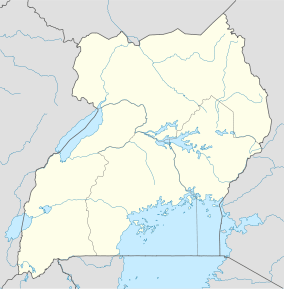Mabira Forest
| Mabira Forest | |
|---|---|
| Mabira Central Forest Reserve | |
 | |
 | |
| Location | Mukono District, Central Region, Uganda |
| Nearest city | Lugazi |
| Coordinates | 0°23′54″N 33°0′59″E / 0.39833°N 33.01639°ECoordinates: 0°23′54″N 33°0′59″E / 0.39833°N 33.01639°E |
| Area | 300 km2 (120 sq mi) |

The Mabira Forest is a rainforest area covering about 300 square kilometres (120 sq mi) (30,000 hectares (74,000 acres)) in Uganda, located in Buikwe District, between Lugazi and Jinja. It has been protected as Mabira Forest Reserve since 1932. It is home for many endangered species like the primate Lophocebus ugandae.
Mabira as a source of Rubber
The Mabira forest was leased in 1900 by the East Africa and Uganda Exploration Company, who then set up the Mabira Forest (Uganda) Rubber Company to handle the concession. Their hopes of obtaining 500,000 lbs per annum from the forest proved unrealistic: the cost of clearing the dense forest around individual trees was too expensive, particularly on account of the poor yields which they got for each tree. As a result the company moved from exploiting wild rubber to planting cultivated rubber, and also coffee.[1]
Deforestation plans
In 2007 the Sugar Corporation of Uganda Limited, a jointly owned by the Government of Uganda and by the Mehta Group, announced plans to clear one-third of the Mabira Forest (around 70 square kilometres (27 sq mi), for sugarcane plantations, and had proposed to the government to de-gazette this land and transfer it to SCOUL. President Yoweri Museveni and his cabinet supported this plan.
The deforestation plans were disputed within Uganda. While environmentalists feared the loss of hundreds of endangered species, increased erosion, the damage of livelihoods of local people and negative impacts on water balance and regional climate, supporters hoped for the creation of jobs. A cabinet paper said the plan would generate 3,500 jobs and contribute 11.5 billion Ugandan shillings to the treasury.
The Kabaka (King) of Buganda opposed the deforestation plan and has offered alternative land for sugarcane production. The Anglican church of Mukono has also offered land.[2]
At least three people were killed during a demonstration of about 1,000 for the protection of the Mabira Forest. There were also riots against Asians, since the Mehta Group is Indian-owned. SCOUL plantations were set on fire, and e-mails and SMS calling for the boycott of SCOUL's Lugazi sugar circulated.
President Museveni defended the deforestation plans, saying that he shall ”not be deterred by people who don't see where the future of Africa lies”. According to him, the Save Mabira activists ”don't understand that the future of all countries lies in processing”. In May 2007, the Ugandan environmental minister announced that the deforestation plans were suspended and that the government is trying to find alternative land for the Mehta Group.
See also
Sources
| Wikinews has related news: Violence in Uganda over forest clearing proposal |
- Protest against deforestation plans on EcoEarth.info
- BBC News: Deaths in Uganda forest protest
- BBC News: Uganda leader defends forest plan
- BBC News: Ugandan plan for forest suspended
- Save Mabira Petition
- ↑ Pitman, C. R. S. (January 1934). "The Mabira Foreat". The Uganda Journal 1 (1): 7–16.
- ↑ New Vision: Kabaka Blocks Mabira Plans
External links
- Mabira Forest: Ugandans Wake Up to the Cost Of Disappearing Forests in Uganda
- Racial Violence, Deaths Rock Kampala As Rioter Protest Mabira Forest Giveaway
| |||||||||||||||||||||||